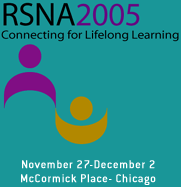
Abstract Archives of the RSNA, 2005
SSJ11-02
In Vivo Elastographic Investigation of Ethanol-induced Hepatic Lesions
Scientific Papers
Presented on November 29, 2005
Presented as part of SSJ11: Ultrasound (Liver)
Kenneth Hoyt, Abstract Co-Author: Nothing to Disclose
Flemming Forsberg PhD, Presenter: Nothing to Disclose
Christopher R.B. Merritt MD, Abstract Co-Author: Nothing to Disclose
Thomas A Krouskop, Abstract Co-Author: Nothing to Disclose
Ji-Bin Liu MD, Abstract Co-Author: Nothing to Disclose
Jonathan Ophir, Abstract Co-Author: Nothing to Disclose
To evaluate strain images (elastograms) of hepatic ethanol injections in a swine model in vivo and to mechanically characterize the stiff lesions induced.
Twenty-eight stiff hepatic lesions were created in 7 swine by ethanol injection (0.33-2.0 ml) at depths of 10 to 25 mm. A modified HDI 1000 scanner (Philips Medical Systems, Bothell, WA) with a 7.5 MHz linear array was used (either in automated or freehand mode), directly on the surgically exposed surface of the liver with respiration suspended. Axial displacements were obtained using the cross-correlation from pre- and post-compressed RF echoes. Ninety-one elastograms were generated as the gradient of the displacement estimates for each A-line. Elastographic lesion sizes were compared to pathology. Multiple regression of elastographic lesion size against swine, ethanol dose, lesion depth, and acquisition technique was performed. Mechanical measurements of the elastic modulus of a subset of lesions and surrounding normal hepatic parenchyma were performed using a nanoindenter (Testworks Inc, Nashville, TN). Samples were tested using applied strain levels of 2 and 5 %.
Elastograms depicted stiff lesions within the softer liver parenchyma, while the ethanol lesions were isoechoic on standard US. Multiple regression showed elastogram lesion size correlated with dose and lesion depth (p 0.11) with an overall correlation coefficient of 0.50. There was no direct correlation between pathology and elastogram lesion sizes (p = 0.97), but trend lines indicated a 4:3 size relationship (elastography to pathology; r2 > 0.98). Measurements showed lesions to have an average modulus of elasticity of 25.9 ± 11.10 kPa compared to 7.3 ± 4.24 kPa in normal liver (p < 0.0001) i.e., lesions were approximately four times stiffer than the normal liver.
Ethanol induced lesions are reproducible across animals. Elastography overestimated lesion sizes compared to pathology, which may be due to strain gradients at the interface of the embedded stiff lesion. These swine studies validate the feasibility of using ethanol lesions for in vivo elastographic testing.
F.F.: This work was supported in part by NCI P01-CA64597 and NIBIB P01-EB02105.
Hoyt, K,
Forsberg, F,
Merritt, C,
Krouskop, T,
Liu, J,
Ophir, J,
In Vivo Elastographic Investigation of Ethanol-induced Hepatic Lesions. Radiological Society of North America 2005 Scientific Assembly and Annual Meeting, November 27 - December 2, 2005 ,Chicago IL.
http://archive.rsna.org/2005/4414549.html

